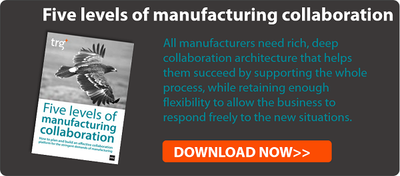According to SIG (2014), analysts are predicting that social media and social apps will become a more significant component of the ERP landscape. Becoming more social can improve your company’s agility and facilitate competitive advantage. Making your enterprise social brings the power of the back office to the front office, helps customers collaborate, and drives growth.
However, as manufacturing industry requires a great deal of team work and individual performance, therefore the need for collaboration within the organisation is even higher, and social ERP system comes in as the solution.
Read more: Collaboration Challenges and How to Overcome with Social ERP

In the last post, we discussed about 2 among 5 levels of collaboration that manufacturers need to go through in order to gain full benefits from collaboration and their social ERP system. Today, we are going to mention more detailed about the remaining 3 levels of collaboration to help manufacturers increase productivity.
3. Design and engineering collaboration
Design, as we know it, is a discipline and process that make the business produces better for the people who use it and is an irreplaceable part of engineering. However, many manufacturing companies encounter difficulty in controlling and sharing design information with key stakeholders.
This problem is especially hard to deal with in distributed engineering and design teams, outsourced manufacturing or multitier supply chain network. Although some companies have data management system to control the situation, design information is still scattered among many systems and scores within the organisation. This causes critical issues for manufacturers since they cannot have design information on time, result in delaying the entire engineering process and profit loss.
As a result, design and engineering collaboration is having a key role in this context. It helps improve and streamline processes across your discrete manufacturing processes to support product development, from the draft scratching time to the market launching period.
You can get that with an advance product life cycle management solution (PLM) within a social ERP system. It functions as a connector between all activities in the engineering process, from design to production. You can gain both foresight and insight about your products, in order to manage the engineering and production process in an effective and cost-saving manner.
4. Vendor and customer collaboration
When a company works with their vendors, they turn over some control of their operation. A vendor could be a supplier or manufacturer of the product, a broker who manages the customs entry or even a consultant who provides the tariff classification of the goods. In all cases, the vendors play an important role in the importer’s supply chain.
On the other hand, customers can be considered as our manufacturing-goal setter, since manufacturers produce based on forecasted customer demands, and customer trends for seasonal products. With the right information about customers delivered at the right time, manufacturing leaders can make decisions as accurate and timely as possible.
A dynamic ERP system will provide web-enabled vendor self-service portals and give manufacturers and their vendors the ability to identify current status as the manufacturing process is moving towards common goals, and from that, save time, effort and money. In addition, manufacturers and vendors can team up as one object and power up to serve customers better.
5. Reporting and analysis collaboration
After making decision, as a result, you need to build strategy from it, while digging into a vast amount of relevant information to gain knowledge from different perspectives for the best insight about organisational business process. Without comprehensive, unified collaboration framework, manufacturers will be more likely to spend more time making the decision, not to mention all following activities.
Business Intelligence (BI) system will help you combine pre-built integrations with pre-built integrations with pre-configured content and easy customised reports for easy information proceeding. BI system will also help to present information in a friendly and responsive interface visually, so that manufacturing leaders can easily get accurate information and generate deeper, more valuable reports and analytics than ever.
Collaboration in manufacturing: altogether as one
Collaboration brings on the table the flexibility and transformational benefits in multiple functional areas such as R&D, operations, Customer services and sales to the manufacturing industry more than ever. With collaboration, all disparate resources from human genuity such as people, systems, customers, vendors, to the means of information power such as analytics & reports, design and engineering, will work together as one and give you the overall power to succeed in rapidly changing environment today.
This is the end of our series “5 levels of collaboration in manufacturing”. Find out the detailed discussion in our full whitepaper today!

 English
English  Vietnamese
Vietnamese 

